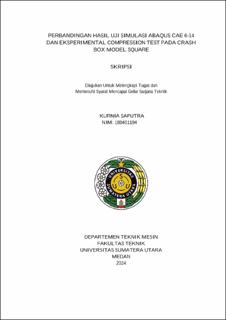Perbandingan Hasil Uji Simulasi Abaqus CAE 6-14 dan Eksperimental Compression Test pada Crash Box Model Square
Comparison of Abaqus CAE 6-14 Simulation Test Result and Experiment Compression Test on Crash Box Square Model

Date
2024Author
Saputra, Kurnia
Advisor(s)
Nasution, Fadly Ahmad Kurniawan
Metadata
Show full item recordAbstract
The crash box is a passive safety system and part of an anti-collision system that
is used to reduce the severity of accidents experienced by passengers or important
parts of the vehicle due to direct impact. The impact box is a thin-walled structure
designed to resist permanent deformation to absorb the energy caused by impact. The
working principle of this Crash Box is to absorb high energy by bringing one segment
to another segment due to the friction that occurs. Apart from that, if the impact energy
is still large, it will continue to the deformation process in the crash box to form several
deformation patterns, including concertina, diamond and mixed-mode or a
combination of concertinadiamond (axisymmetric - diamond) patterns. The crash box
used in this research is a thin-walled tube structure with a thickness of 3 mm, and a
square-shaped crash box with a height of 100 mm, and a variety of one-hole, two-hole
and three-hole crash box models are provided on two sides of the crash box wall.
Based on the analysis carried out, the energy absorption value of the crash box with
variations in holes carried out using simulations, the energy absorption results in the
one hole model were 29.59707 Joules at a displacement of 2.4 mm, and experimentally
the energy absorption value was obtained at 27.408 Joules at a displacement of 2. 4
mm, in the two-hole model simulation it is 27,415 joule displacement 2.5 mm, and in
the experimental 29,9375 joule displacement 2.5 mm, in the three-hole model
simulation it is 28,568 joule displacement 2.5 mm, and in the experimental it is 29,
2375 joules displacement 2.5 mm.
Collections
- Undergraduate Theses [975]
